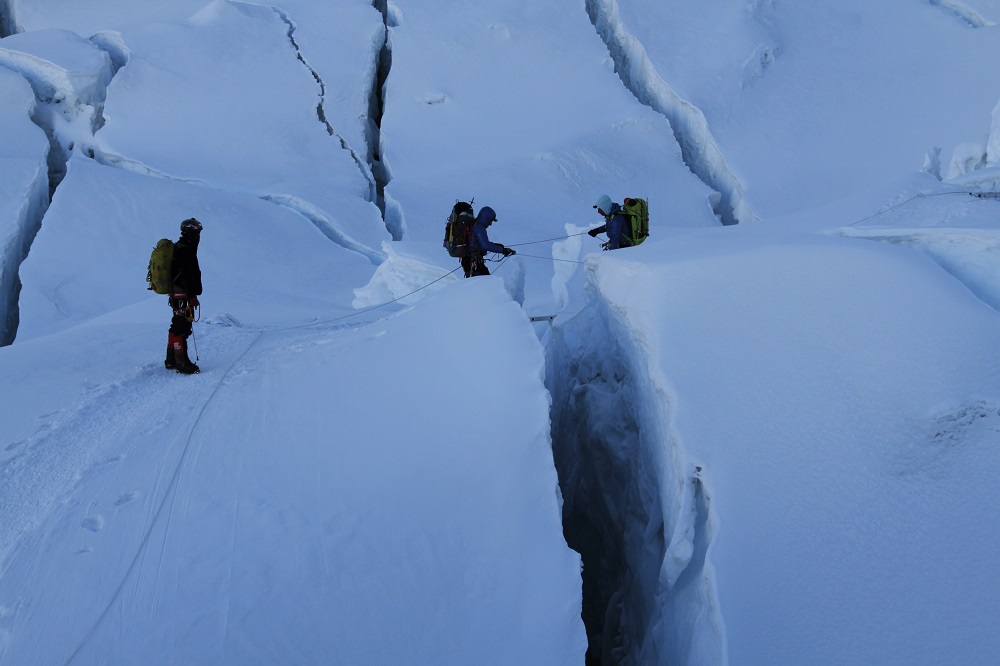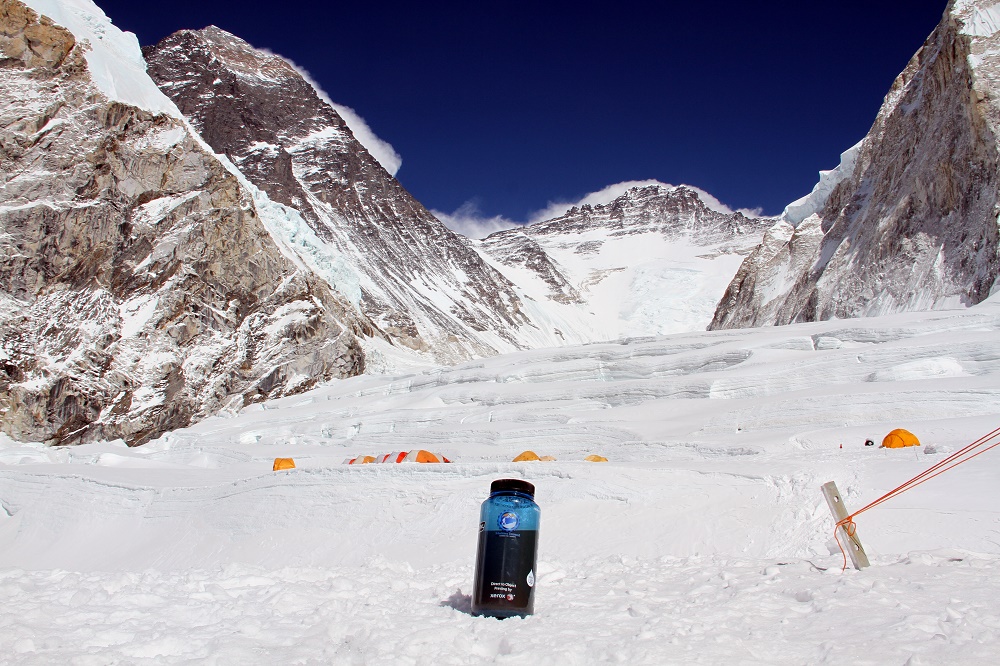By Mathieu Durand
(From the editor: Mathieu Durand (right) is a workflow process automation consultant for sales teams at Xerox Canada. He also holds a passion for rock climbing and mountaineering. This article tracks Mathieu’s second attempt to climb Mount Everest. The entries that follow were excerpted from Mathieu’s blog, Climbing the 7 Summits. The excerpts have been edited for brevity.
Photo above: Sunrise on Mount Pumori. All photos courtesy of Mathieu Durand.)
Mount Everest
May 30, 2017 — “… [to] go to Everest … you must be, as Greg Vernovage explains, “bullet-proof” to be able to climb. Being bullet-proof means that you are as strong as you can physically, mentally and emotionally. When he said that for the first time, I knew what he meant, but on the other hand, I thought, “It cannot be that hard.” Well, two months later, I’m back home, I lost 25 pounds, lost 20 percent of the power in my legs, it was a roller coaster of emotions to be sick away from home …
Greg was right: Everest is hard in every way, physically, mentally and emotionally.
Pneumonia forced him to abandon his 2017 attempt to climb Mount Everest. One year later, his second attempt is underway. Follow Mathieu Durand’s journey.
October 31, 2017 — Yes, it’s true! I am very proud to announce that I will be officially back in Nepal in April 2018 to fulfill my long-standing dream of reaching the roof of the world. The minute I left base camp in May 2017, I knew I would be back sooner than later considering that the power of attraction of a mountain like Everest is just too strong to ignore.
Why am I going back? Why Everest? This is a really difficult question to answer with a true and deep answer inside me, and it will be the subject of a complete publication. But know for now that the passion and determination to live my dreams are what motivates me every day to train myself to be on Everest in 2018.
March 31, 2018. Departure day — For months now, I’ve been training mentally and physically to get back to top form after my first attempt in 2017. I learned a lot from last year and, so far, I feel like it [has paid off]. I was calm, not too nervous, and ready to go as if it was just another trip. But last night, I felt like I had an army of butterflies in my stomach. I had a big day on Friday and fell asleep like a rock. When I woke up, I thought it was 7 a.m., but only two hours had passed, and it was 1 a.m. I tried to go back to sleep but all the memories of 2017 came knocking on the door, the good ones, like the bad ones. It may have lasted half an hour, until I considered that 2018 is very different for me. I went back to dreaming and woke up at 4 a.m., then at 6 a.m. and finally at 7:30 a.m. I got out of bed — this will be the last time for a long time. I must have spent 30 minutes in my shower. Of all the things I miss in the mountains, my bathroom is the only thing I really wish I could hang [on to].
April 9, 2018 — For climbers like me, the mountains we climb are not just rock and ice, but dreams, passion, desires and more. The climbing is a way for me to feel alive and to connect to the earth in a way that would otherwise be impossible. The feeling that you get to be no bigger than a pebble compared to all the mountains, especially the Himalayan giants, puts into perspective the place of the human being in this world. I do not climb for a cause, I do not climb for a world record or for money, I climb for myself. Yes, mountaineering is known to be a selfish sport.
People who wonder why we climb are right: The stakes sometimes seem too high, but there is no other feeling than to live the moment with oneself at the top of a mountain after weeks of effort. The sunrise, the purity of the air, the landscapes, the scene is simply indescribable. I guess that’s why most mountaineers become so emotional when they walk the last meters. I climb, too, simply because I can. I can live those special moments that only other climbers can understand. I hope to be able to share my stories and inspire others to go outside and climb, because you connect not only with nature but also with many people around the world. I have made great friends on the mountainside over the years. All those cold nights spent in a jacket listening to the countless stories of others’ expeditions are a lesson in life. You can learn a lot at school, but you will never learn more about yourself than on an expedition, especially during a day at the summit.
April 18, 2018 — Early to bed for a 3 a.m. wake up time. I could not really sleep in the cold night. Trying to relax and tell myself that the icefall is just like any other climb. (But it’s not.) Stressed about the memories of last year where my first run was a disaster. 00:00, 1 a.m., 2 a.m., 2:15. I finally fall asleep to only wake up 45 minutes later to the sound of the zippers and clink of the climbing gear. Getting out of a warm sleeping bag in the darkness of the night is never easy. We have a quick breakfast and started our way around 4 a.m. towards crampon point. We stopped by the Puja altar to make a prayer for the sake of safe passage and off we go by the beam of our headlamps. The night was foggy and silent.

(Mathieu’s ascent on Mount Everest is underway as this article is being published. His team climbs for five days, then rests for five. When WiFi is available, Mathieu updates his blog during his rest intervals. His ongoing updates will be posted on Climbing the 7 Summits.)
Water on Mount Everest
Finding water on Mount Everest is not difficult, but it is available only in the form of snow. We boil down snow for drinking and cooking. But filling water bottles with melted snow for the climb is a partial solution. The best way to thaw your water bottle after a really cold night is to drop it in boiling water.
Physical and emotional conditioning aside, mountain climbers rely on sponsors to make their treks possible. In exchange, we carry their logos on our equipment, including our water bottles. Typically, the logos (and our names) on the water bottles are printed on stickers. You can quickly see what happens to the stickers after you boil your water bottles a few times. Or when you wash your bottles in a dishwasher.
At camp 1. Everest on the left; Lhotse in the middle. Water is front, center and everywhere.
The solution is to print the logos and names directly on the water bottles. Xerox has the capability to print graphics and text directly to three-dimensional objects. This Direct to Object printing technology can be used at any point in a manufacturing process, or even at retail operations. Xerox showcased its Direct to Object printing technology at a visitors’ tent during the Xerox Rochester International Jazz Festival in 2017. Festival patrons purchased items such as a sleeve of golf balls, a travel wine tumbler, a water bottle or a notebook, and Xerox personalized these items on a Direct to Object Printer in a matter of minutes.
For my climb up (and down) Everest, I expect that the printing on my water bottles will endure, despite big temperature fluctuations and moisture. So far so good.
A big thank you for the tremendous support, physical and mental training I received from Paulo, Vince, Scott, James, Dave, Marie-Hélène, JF Ménard and all the others at P2 Montreal – PowerWatts. I could not be better prepared than with P2 Team.
from Xerox Connect https://ift.tt/2HBoQ3J
via https://ifttt.com/ IFTTT





No comments:
Post a Comment